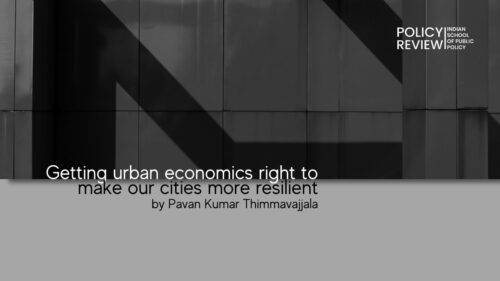
Getting Urban Economics Right to Make our Cities more Resilient

India’s mega-cities like Delhi-NCR, Hyderabad, Mumbai and Bengaluru are no strangers to occasional flooding following heavy rains. These often rake up never-ending debates on and off social media regarding the effectiveness of municipal administrations and the callousness of cash-rich corporations. While it is an annual affair, it merits consideration for those concerned about urban space and are keen to help cities become not just growth drivers providing employment and housing but also hubs of culture, social mixing and climate-resilient in the long term.
The general grievance amongst those residing in the big cities, on these issues is the failure of the Revenue Departments and Municipal Corporations at the State and City-Level to act on land encroachments, illegal constructions and elimination of land cartels distorting the real estate market. The net result of such a failure has been that our cities have grown into bigger agglomerations with ineffective resistance to natural calamities, poor housing or residential grids and a lack of access to reasonable public transport. This produces non-remunerative land use patterns and puts severe strain on the Urban Local Bodies to gather finances for providing necessary economic and social infrastructure and, in the process, makes them less resilient in adverse circumstances.
Land-Use Patterns in Urban India
The recent occasion where Noida’s SuperTech Towers being razed to the ground following a Supreme Court judgement might have gone ‘viral’, but a similar case of winding up an illegal construction in Kochi’s Maradu Towers’ demolition in 2020 ought to jog the public memory. Both present a case of how urban land spaces can be encroached in a manner such that the negative externalities generated due to improper procedures or policies far outweigh the short-lived costs of relocating and housing for citizens who look forward to cleaner cities and access to workplaces.
The current land-use patterns in India vary from city to city depending on how the market forces work in tandem with the State. According to Garg et.al, (2022), land-use can be classified into – Agriculture, Built-up, Urban green spaces, Urban open spaces, Forest, Water bodies, and Rivers. Land theory flowing from Von-Thunen’s formulations and a later modification of the same in the Alonso-Muth-Mills model suggests that land use is directed towards that use which pays the highest rent, given spatial indifference exists. In simple terms, if developers are willing to pay a significant amount as rent to use a certain parcel of land, to build multi-storied office spaces in the city centre, the urban space in the city centre would most likely go for such use. The rents would come down as the distance from the city centre increases, and the land use adjusts accordingly. From the Indian city perspective, if one were to map the theory with the ground reality, we find that there is indeed a certain level of matching.
With tight Floor Area Ratio (FAR) restrictions, Indian cities are expanding outwards with little scope for central city areas to develop well, leading to sprawls and growth in peri-urban areas. Bengaluru’s IT Hub developing outside the original city boundaries is a case in point. Usage-wise, agricultural land is being converted into built-up areas in a big way in most cities. Data from Statista shows New Delhi saw a 177.5% rise in built-up areas between 1975 and 2015. Likewise, Hyderabad’s built-up area went up from 317 square km in 2000 to 364 square km in 2015, and Bangalore’s, as reported by Varma et. al. (2017) went up from 213 square km in 2001 to 358 square km in 2016. With GIS, it would be easier now to study how the increase in built-up area has impacted the weather patterns and city grid in general, given the growing low-cost housing options in the peripheries of most cities. A socio-economic analysis of changing land-use patterns in our cities is now essential to know how the land market is evolving and how responsive our ULBs are. It would enable planners to propose corrective measures in terms of costs and promote a guided vision of city development sans any ‘Master Plans’ which have now become archaic.
Cash-Rich ULBs… but how is the money being used?
It is well understood that a majority of ULB financing is generated by way of local tax collections (property tax, development tax, vacant land tax, betterment levy, impact fees) and grants of the State Governments through their annual budgets. Data from City Finance, which is a portal developed by MoHUA in partnership with the well-known city advocacy and research group ‘Janaagraha’ showed that ULBs with a population of more than 4 million spent Rs. 5751 Crore, per capita in FY 2020-21. Where, then, did the expenditure go? In such cities, capital expenditure per capita was only 28% of the total per capita capital expenses. A more detailed breakup shows that 8% of the ULB money in major cities is used to run the administration while establishment expenses and operations & maintenance together constitute 56% of the expenditure. Only 1.9% was spent to clear interest payments. Remaining 33% went to what has been classified as ‘Other Expenditures’. Therefore, it is evident that capital expenditure takes a backseat at the ULB level, and as a result, there is a gestation period between plans for city projects and their eventual execution.
Majority of capital expenditure in terms of building roads, flyovers, transit corridors end up being planned at the municipal level but are scrutinized at the state level and then pursued, due to paucity of finances. It is imperative we get our urban economics right by exploring alternative financing models at the ULB level to fund critical urban infrastructure.
T.O.D – a novel approach to city finance
Moving forward, our cities need to invest heavily in innovative ideas such as Transit Oriented Development (T.O.D) and do away with the Master Planning approach which was criticised by the National Urban Policy Framework, 2018. In simple terms, T.O.D refers to developing an effective network of residential-cum-commercial spaces alongside transit corridors such as metro-lines or suburban local railway stations, enabling people living in the ‘influence zones’ of each station to commute to and from work faster (and even walk till office), through sustainable modes of transport. This would make our cities ‘walkable’, reduce the income divide, and improve focus on services for pedestrians. The key to this lies in the land.
Given the dynamic nature of urban land, T.O.D can also help unlock land value in a big way by commercialising vacant lands on the corridors and pursuing corridor re-development. Cities the world over have taken it up to reduce congestion and pollution. Ahmedabad and Bengaluru have shown the way by framing TOD policies. More cities in India need to adopt it to plan their future course by leveraging on the current trends in the housing market as well as existing transport infrastructure, to help sustain their finances and become more resilient.
Register your Interest to Study at ISPP

